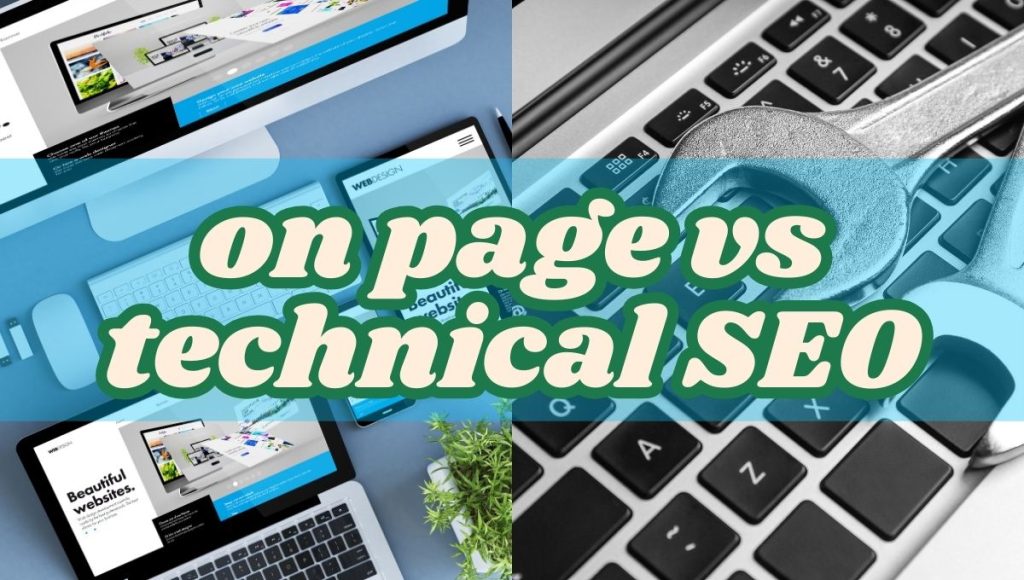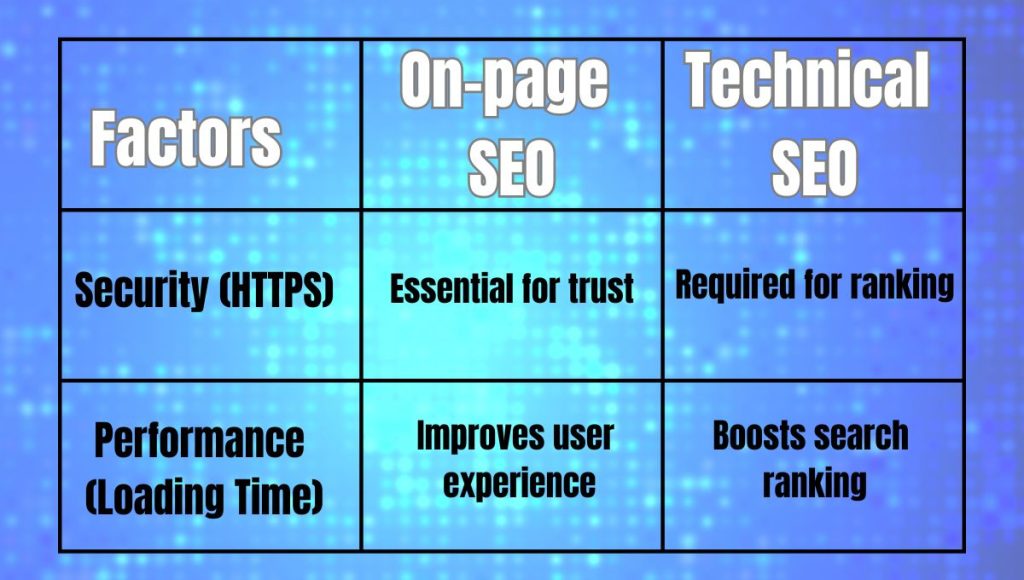On-page SEO involves tailoring each web page to target specific keywords for better search engine visibility.”Technical SEO optimizes the backend structure and foundation of a website.
On-page SEO is crucial for improving the visibility and relevance of specific web pages. It involves keyword placement, meta descriptions, header tags, and content quality. Technical SEO ensures that a website is optimized for crawling, indexing, and overall performance. This includes site speed, mobile friendliness, XML sitemaps, and structured data.
Both on-page SEO and technical SEO are essential for a comprehensive SEO strategy. They work together to improve search engine rankings and user experience. Mastering these aspects can significantly impact your website’s success in search engine results pages (SERPs). Prioritize both to achieve optimal online visibility.
Hello reader! In this article, I’ll explain the differences between on-page SEO and technical SEO.

What Is On-page SEO?
On-page SEO refers to optimizing individual web pages. The aim is to rank higher and earn more relevant traffic in search engines. This involves improving the content and HTML source code of a page.
Key Elements
- Title Tags: These are crucial for search engines and users.
- Meta Descriptions: Short summaries that appear in search results.
- Header Tags: Use H1, H2, and H3 tags to structure content.
- URL Structure: Keep URLs short and include target keywords.
- Internal Links: Link to other pages within your site.
- Content Quality: Provide valuable, relevant, and engaging content.
- Keyword Optimization: Use keywords naturally within the content.
- Image Alt Text: Describe images to help search engines understand them.
Best Practices
- Title Tags: Use primary keywords near the beginning.
- Meta Descriptions: Write compelling descriptions under 160 characters.
- Header Tags: Use H1 for the main title, H2 for subheadings.
- URL Structure: Use hyphens to separate words in URLs.
- Internal Links: Link related articles within your content.
- Content Quality: Write clear, concise, and informative content.
- Keyword Optimization: Avoid keyword stuffing; maintain readability.
- Image Alt Text: Use descriptive and relevant keywords.
What Is Technical SEO?
Technical SEO ensures your website meets search engine requirements. It is the foundation for a well-optimized site. Without it, other SEO efforts may fail.
Technical SEO focuses on improving the infrastructure of your website. This includes aspects like speed, mobile friendliness, and security.
Core Components
Several core components form the backbone of technical SEO. These elements help search engines understand and rank your site.
|
Component |
Description |
|
Site Speed |
Fast-loading pages enhance the user experience and SEO rankings. |
|
Mobile-Friendliness |
Websites must be responsive for mobile users. |
|
SSL Certificate |
Security protocols like HTTPS are essential for trust and ranking. |
Essential Techniques
Technical SEO involves various essential techniques. These techniques improve your website’s performance and visibility.
- XML Sitemaps: Help search engines index your site better.
- Robots.txt: Guides search engine crawlers on what to index.
- Canonical Tags: Prevent duplicate content issues.
- Structured Data Markup: Enhances search result appearance with rich snippets.
Ensuring these techniques are in place can significantly impact your SEO success.
Content Optimization
Content optimization is key to successful SEO. It ensures your content reaches the right audience. This process involves many steps. These steps improve your site’s visibility in search engines.
Keyword Research
Keyword research is the first step in content optimization. It helps you find the terms people search for. Use tools like Google Keyword Planner or Ahrefs. These tools help identify popular keywords. Focus on keywords with high search volume and low competition.
Create a list of primary and secondary keywords. Use these keywords naturally in your content. Avoid keyword stuffing, as it can hurt your rankings. Place primary keywords in headings and the first paragraph.
Meta Tags
Meta tags provide information about your web page. They include the title tag and meta description. These tags help search engines understand your content. They also impact click-through rates from search results.
The title tag should be under 60 characters. It must include your primary keyword. The meta description should be under 160 characters. It must be compelling and include a call-to-action. Both tags should be unique for each page.
Both on-page SEO and technical SEO impact content optimization. On-page SEO focuses on the content itself. Technical SEO addresses the site’s backend structure. Both are crucial for better search engine rankings.
Site Structure And Navigation
A well-organized site structure and navigation system are crucial for both users and search engines. It helps users find what they need quickly, and it helps search engines understand your site’s hierarchy. This section delves into two key aspects of site structure and navigation: URL structure and internal linking.
Url Structure
A clean and descriptive URL structure improves the user experience and search engine rankings. Each URL should be simple, readable, and include relevant keywords. Avoid long strings of numbers or special characters.
Here are some best practices for URL structure:
- Use hyphens to separate words (e.g., example.com/your-page).
- Keep URLs short and descriptive.
- Include primary keywords.
- Use lowercase letters.
Internal Linking
Internal linking connects your website’s pages, making it easier for users and search engines to navigate. It distributes page authority and helps search engines understand the relevance of content.
Benefits of internal linking include:
- Improved user experience.
- Enhanced crawlability.
- Better distribution of link equity.
- Boosted page views and session duration.
If you want to discuss more, click here
Follow these best practices for internal linking:
- Use descriptive anchor text.
- Link to relevant content.
- Avoid excessive links on a single page.
- Ensure links are easily accessible.
Mobile Optimization
Mobile optimization is essential for both on-page SEO and technical SEO. Ensuring your website is mobile-friendly can significantly improve your search engine rankings and user experience.
Responsive Design
A responsive design adapts to different screen sizes. This ensures that your website looks great on all devices, from smartphones to tablets. Using a responsive design is crucial for mobile optimization.
- Enhances user experience
- Increases mobile traffic
- Improves SEO rankings
Responsive design uses flexible layouts and images. It also leverages CSS media queries.
Page Speed
Page speed is a critical factor for mobile optimization. Faster loading pages provide a better user experience and improve SEO.
- Compress images to reduce load time.
- Minimize HTTP requests.
- Use browser caching.
Google’s PageSpeed Insights tool can help you analyze and improve your website’s speed.
Here’s a comparison of on-page SEO and technical SEO aspects for mobile optimization:
Aspect | On-page SEO | Technical SEO |
Responsive Design | Ensuring content is easily readable on mobile devices. | Implementing CSS media queries and flexible layouts. |
Page Speed | Optimizing images and content for faster load times. | Using server-side optimizations like caching and compression. |
Security And Performance
In the realm of SEO, security and privacy are crucial factors. They play a significant role in both on-page SEO and technical SEO. Ensuring your website is secure and fast can lead to better rankings and a positive user experience.
Https
HTTPS is an essential part of website security. It encrypts data between the user’s browser and your server. This encryption protects sensitive information, such as passwords and credit card numbers. Google favors HTTPS websites, making it a ranking factor. Ensure your site uses HTTPS to boost trust and improve SEO.
Site Loading Time
Site loading time greatly impacts user experience and SEO. Faster sites rank higher on search engines. Users prefer quick-loading websites. You can improve loading times by:
- Optimizing images
- Minifying CSS and JavaScript files
- Using browser caching
- Implementing a Content Delivery Network (CDN)
These steps will help reduce loading times and enhance user satisfaction.

Analytics And Monitoring
Understanding how users interact with your website is crucial. Analytics and monitoring provide insights into your site’s performance. This helps you improve both on-page SEO and technical SEO. Let’s explore the tools and metrics for tracking success.
Tracking Tools
Several tools can help you monitor your website’s performance. These tools collect data and offer insights. Here are some popular choices:
- Google Analytics: tracks website traffic and user behavior.
- Google Search Console: Monitors search performance and indexing issues.
- SEMrush: Provides SEO audits and competitive analysis.
- Ahrefs offers backlink analysis and keyword tracking.
These tools help you understand what works and what needs improvement.
Performance Metrics
Tracking the right metrics is essential for success. Here are some key performance metrics for on-page SEO and technical SEO:
Metric | Description |
Organic Traffic | Number of visitors from search engines. |
Bounce Rate | Percentage of visitors who leave quickly. |
Page Load Time | Time it takes for a page to load fully. |
Crawl Errors | Issues preventing search engines from indexing pages. |
Keyword Rankings | Positions of your target keywords in search results. |
Monitoring these metrics helps you optimize your website effectively.
em ipsum dolor sit amet, consectetur adipiscing elit. Ut elit tellus, luctus nec ullamcorper mattis, pulvinar dapibus leo.
Conclusion –
On-Page SEO and Technical SEO
Mastering both on-page and technical SEO is crucial for online success. Each plays a unique role in improving visibility. Focus on optimizing content and ensuring technical aspects are in top shape. Balancing these strategies can significantly boost your search engine rankings and overall digital presence.

